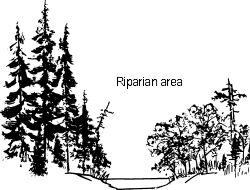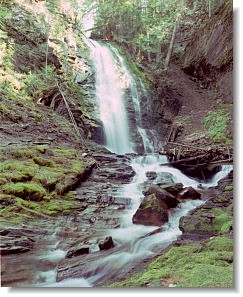3.6 Special habitats
Learner outcomes
On completion of part 3E, you will understand the role that the stand level component special habitats plays in forest biodiversity
- Describe special habitats
- Identify forest management applications for special habitats
- Describe the role of special habitats within forest biodiversity
The questions on the left side of the page are to assist you in keeping actively involved in the material and your learning Answer them silently or in writing.
General information about special habitats
Special habitats are any uncommon stand or landscape features such as riparian areas, wetlands, gullies, rock outcrops, cliffs and taluses, cave entrances, avalanche tracks, and meadows. These special features can be important habitat because they generally provide microhabitat for wildlife and plants uniquely adapted to, or dependent on, these features. Often, these special habitats can be used as biological control points.
Special habitats such as riparian areas, gully, and outcrop complexes are often unique or less common stand features. They are often associated with specific flora, fauna, or microhabitat processes not common in the stand or landscape.

Riparian
What role do special habitats play in forest biodiversity? Riparian are areas adjacent to a stream, lake, pond, or wetland where water influences the vegetation. Riparian areas often act as linear travel corridors.
-
Because of the influence of water, riparian areas often have a buffered micro-climate (warmer in winter, cooler in summer)
Provided they have suitable associated wildlife tree characteristics, riparian management areas and other constrained areas, such as gullies and rock outcrops, can contribute to wildlife tree patch (WTP) requirements.
Wetlands
What else do you know about wetlands?
Wetlands include swamps, bogs, and small ponds and marshes.
- The complex of water, vegetative structure, physiography and microclimate all contribute to the ecological diversity of these habitats
- Because of their high site productivity and more complex habitat structure (downed wood, standing dead trees, shrub and mixed tree species composition), riparian areas are often the most heavily used wildlife habitats
Talus slopes, cliffs, and rock outcrops
Talus slopes are areas of accumulated broken rock, usually at the base of rock cliffs or steep slopes. The larger the size of rock pieces, the greater their significance as wildlife and plant habitat. Larger rock talus is more stable and provides larger living spaces for plants and animals.
- Cliffs are steep and vertical or overhanging rock faces. Their significance as wildlife habitat depends on the type of rock material that affects their stability. For example, sedimentary rock weathers relatively quickly compared to igneous rock, and is thus of lower value.
- Caves are underground chambers that are open to the surface. They can be either natural (as in limestone caves) or artificial (as in abandoned mine shafts and tunnels). They can be deep or shallow, and occur in various types of rock formations.
- Rock outcrops are areas of exposed bedrock and shallow, organic soils features. They occur at various elevations and may be natural, undisturbed features or a result of disturbance (e.g., landslide, fire, erosion or windthrow).
Importance of special habitat features
- Name some mammals, birds and reptiles.
These special features are important types of habitat because they generally concentrate a complex variety of wildlife and plants uniquely adapted to, or dependent upon, these features. Caves, cliffs and talus slopes typically provide protective cover and nesting habitat to small mammals, birds, and reptiles. These features also contribute to distinct changes in stand structure, and are thus an important attribute to stand level diversity.
Applications to forest management
- Are there other applications? If so, describe them.
Typically, the plant communities associated with these features are quite fragile and cannot be easily replaced if disturbed. They are very difficult to recreate or to enhance, and for these reasons should be disturbed as little as possible, if not avoided altogether.
Typically, these features do not support a commercially viable forest cover, and thus are ideal focal points upon which to practice biodiversity management practices.
For example, reserves can easily be established around these features to provide wildlife trees, coarse woody debris, advance regen patches, and undisturbed shrub communities for structural biodiversity enhancement.
- Use special habitats as biological anchors for placement of wildlife tree retention areas wherever appropriate.
- Designation as reserve areas will avoid disturbance of special habitats when harvesting or conducting stand-tending operations.
- Where possible, avoid riparian areas when locating roads and landings.
Special habitats - conclusion
Review of learner outcomes
- Are you able to describe special habitats?
- Are you able to identify forest management applications for special habitats?
- Can you describe the role of special habitats in forest biodiversity?
If you cannot complete these questions, what will you do so that you are able to?
Transfer of learning
Using a fishbone diagram, list the various special habitat applications to forest biodiversity that are either in the material or those you have thought of. Turn your sheet of paper to a landscape position. Add as much detail as you need to explain each of the applications. Only single words or phrases are needed to express your ideas. Each idea is written on a line. Use a different color for each application. Many people find that color is a great way to remember related ideas.
Reflections
How will knowing about special habitats as one of the six stand level components of forest biodiversity assist me in my job? (Think of 3 – 5 ways)




